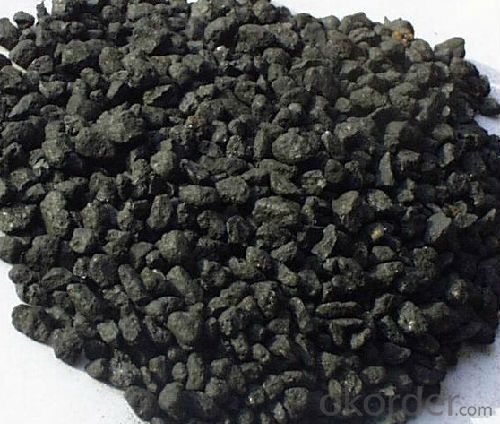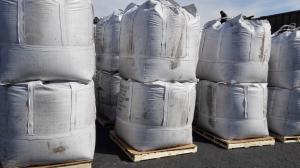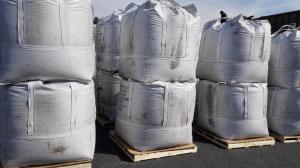Calcined Petroleum Coke FC98% S0.7% Cheap Price
- Loading Port:
- Tianjin
- Payment Terms:
- TT or LC
- Min Order Qty:
- 20 m.t.
- Supply Capability:
- 1500 m.t./month
OKorder Service Pledge
OKorder Financial Service
You Might Also Like
Packaging & Delivery
| Packaging Detail: | 50kg/bag 100kg/bag 1000kg/bag Or according with client need to do |
| Delivery Detail: | 2 weeks |
Specifications
Calcined Petroleum Coke FC98% S0.7% Cheap Price
Petroleum coke products can be divided into needle coke, sponge coke, projectile coke and coke breeze four kinds.
Calcined Petroleum Coke
F.C.: 98.5%MIN
ASH: 0.8% MAX
V.M.: 0.7%MAX
S:0.5%MAX
Moisture: 0.5%MAX
Structure
Calcined Petroleum Coke FC98% S0.7% Cheap Price
Shape: granule
Dimensions: 0-1mm, 1-5mm, 1-6mm, 2-8mm, etc
Product Type: Carbon Additive
C Content (%): 98-99.5% MIN
Working Temperature: -
S Content (%): 0.5%-0.7%MAX
Ash Content (%): 0.7%MAX
Volatile:0.8%MAX
Moisture: 0.5% MAX
ADVANTAGE: low ash & sulfur
COLOR: Black
Feature
Calcined Petroleum Coke FC98% S0.7% Cheap Price
Physics and chemistry performance :
Unit | Index | |||||
No.1 | No.2 | No.3 | ||||
Density | g/cm3 | 2.04 | 2.00 | 2.00 | ||
sulphur content | %≤ | 0.5 | 1.0 | 2.5 | ||
volatility | %≤ | 0.5 | 0.5 | 0.5 | ||
ash content | %≤ | 0.5 | 0.5 | 0.5 | ||
moisture | %≤ | 0.3 | 0.5 | 0.5 | ||
charcoal | %≤ | 98.5 | 98.0 | 98.0 | ||
Image
Calcined Petroleum Coke FC98% S0.7% Cheap Price


FAQ:
Calcined Petroleum Coke FC98% S0.7% Cheap Price
How to classify calcined petroleum coke?
1) According to difference of sulfur content, can be divided into high sulfur coke (sulfur content more than 4%), sulphur in coke sulfur content (2% 4%) and low sulfur coke (sulfur content below 2%).
2) Petroleum coke products can be divided into needle coke, sponge coke, projectile coke and coke breeze four kinds:
3) Needle coke, has obvious needle-like structure and fiber texture, mainly used for steel-making in high power and ultra-high power graphite electrode. As a result of needle coke in sulfur content, ash content, volatile matter and true density and so on have strict quality requirements, so the production process of needle coke and raw materials have special requirements.
4) The sponge coke, high chemical reactivity, low content of impurities, mainly used in the aluminum industry and carbon industry.
5) Focal or spherical coke: the projectile shape is round, diameter 0.6-30 mm, usually from the production of high sulphur, high asphaltic residual oil, can only be used as industrial fuel power generation, cement etc.
6) Coke breeze: fluidized coking process, the fine particles (0.1- 0.4 mm) in diameter, high volatile, high expansion coefficient, cannot be directly used for electrode preparation and carbon industry.
Advantage:
Calcined Petroleum Coke FC98% S0.7% Cheap Price
1. High quality and competitive price.
2. Timely delivery.
3. If any item you like. Please contact us.
Your sincere inquiries are typically answered within 24 hours.
- Q:What is the role of carbon in the formation of coal, oil, and natural gas?
- The role of carbon in the formation of coal, oil, and natural gas is that it is the primary component in these fossil fuels. Over millions of years, organic matter such as plants and microscopic organisms are buried under layers of sediment. The heat and pressure of the Earth's crust over time converts this organic matter into fossil fuels. Carbon, being the main element in these organic materials, is preserved and transformed into coal, oil, and natural gas through this process.
- Q:Want advanced reinforcement, but I do not know where the high furnace rock carbon, looking for someone to guide...
- Landlord Hello, there are 51 bags sold in the mall, send the hope to adopt, thank you!
- Q:How does carbon impact the formation of smog?
- The formation of smog is greatly influenced by carbon, specifically carbon monoxide (CO) and volatile organic compounds (VOCs). When fossil fuels are burned, like in vehicle engines or power plants, they release carbon monoxide into the air. This colorless and odorless gas can react with other pollutants under sunlight to create ground-level ozone, a major part of smog. Moreover, volatile organic compounds (VOCs), which are carbon-based compounds, are also emitted from various sources such as industrial processes, gasoline vapors, and chemical solvents. These VOCs can undergo chemical reactions with nitrogen oxides and sunlight, resulting in the formation of ground-level ozone. Both carbon monoxide and VOCs contribute to the creation of smog by reacting with nitrogen oxides (NOx) when exposed to sunlight. This reaction produces ground-level ozone, which is a primary component of smog. Ozone is detrimental to human health and the environment, and the presence of carbon emissions worsens its formation. To mitigate the formation of smog, it is crucial to reduce carbon emissions. Transitioning to cleaner and more sustainable energy sources, such as renewable energy, can help decrease the release of carbon into the atmosphere. Additionally, implementing stricter emissions standards for vehicles and industrial processes can also play a role in reducing carbon emissions and consequently limiting the formation of smog.
- Q:What is the basic principle of carbon fourteen detection?
- There are 3 kinds of carbon isotopes in nature, and their weight ratio is 12:13:14. They are expressed by carbon -12, carbon -13 and carbon -14 respectively. The first two are stable isotopes. Carbon -14 is radioactive. It exists in the atmosphere and is generated in the upper atmosphere by cosmic rays, neutrons, and atmospheric nitrogen nuclei. It combines C4O2 molecules with oxygen in the atmosphere, which is the same as carbon dioxide (CO2). Therefore, it mixes with carbon dioxide to participate in the natural carbon exchange movement. It is absorbed by plants by photosynthesis and stored in plants. People and animals need to eat plants, so they are also stored in human and animal bodies. During the life of the organism, they continuously acquire the radioactive carbon from the atmosphere. But when an animal or plant dies, it stops absorbing and reduces the radioactive carbon in the body. For about 5730 years, its content could be attenuated by half. So physicists call the half-life 5730 years. Therefore, as long as the instruments to measure the trees, grain, animal bones and bone biological remains in the existing carbon content of -14, compared with its original carbon -14 level, you can calculate their death in many years ago, which can be inferred and their coexistence remains (such as construction sites, tombs or other relics how many years have elapsed since).Pro, please [adopted the answer], your adoption is the driving force for my answer, thank you.
- Q:Stability, primary carbon, two carbon, three carbon, four carbon
- In hydrocarbon molecules, with 3 hydrogen atoms of carbon atoms is called the first carbon atom (also called a carbon atom or primary carbon atom); with 2 hydrogen atoms of the carbon atoms is called second carbon atom (also called the two carbon atoms or secondary carbon atoms); with 1 hydrogen atoms of the carbon atoms is called third carbon atoms (also called the three carbon atom or tertiary carbon atoms)
- Q:What are the implications of melting permafrost on carbon emissions?
- The implications of melting permafrost on carbon emissions are significant and concerning. Permafrost refers to the permanently frozen ground found in cold regions, consisting of soil, rocks, and organic matter. It acts as a large carbon sink, storing vast amounts of organic material, such as dead plants and animals, which have been frozen for thousands of years. However, with rising global temperatures, permafrost is thawing at an alarming rate, leading to potential release of this stored carbon into the atmosphere. When permafrost thaws, the organic matter within it decomposes, releasing greenhouse gases, particularly carbon dioxide (CO2) and methane (CH4), into the atmosphere. Methane is an especially potent greenhouse gas, with a global warming potential over 25 times greater than that of CO2 over a 100-year period. The release of these gases further contributes to climate change, exacerbating the already accelerating warming trend. The implications of melting permafrost on carbon emissions are twofold. Firstly, the release of large amounts of CO2 and methane from thawing permafrost can significantly amplify the greenhouse effect, leading to more rapid and intense climate change. This can result in a feedback loop, where increased warming causes more permafrost thawing, releasing more carbon, and further accelerating global warming. Secondly, the release of carbon from permafrost also affects global carbon budgets and climate change mitigation efforts. The stored carbon in permafrost is estimated to be twice as much as is currently present in the Earth's atmosphere. As this carbon is released, it adds to the overall carbon emissions, making it more challenging to achieve emission reduction targets outlined in international agreements, such as the Paris Agreement. It also means that efforts to limit global warming to well below 2 degrees Celsius above pre-industrial levels become even more crucial. Furthermore, the release of carbon from permafrost also impacts local ecosystems and communities. Thawing permafrost can lead to the destabilization of infrastructure, including buildings, roads, and pipelines, as well as the disruption of traditional livelihoods, such as hunting and reindeer herding. It can also cause land subsidence and increased coastal erosion, threatening coastal communities and biodiversity. In conclusion, the implications of melting permafrost on carbon emissions are far-reaching. It not only exacerbates climate change by releasing potent greenhouse gases into the atmosphere but also hampers global efforts to mitigate carbon emissions. Sustainable actions to reduce greenhouse gas emissions and protect permafrost ecosystems are crucial to minimize these implications and safeguard our planet's future.
- Q:How does a kebab cook at home?
- It's easy to burn carbon at home1, put on the gas stove, ignited after use,2, pour some cooking oil in waste paper or Suibu, carbon on top, can be ignited
- Q:How does carbon affect the formation of droughts?
- Carbon dioxide (CO2) and other greenhouse gases play a significant role in the formation of droughts. The increase in carbon emissions from human activities, such as burning fossil fuels and deforestation, has led to a rise in atmospheric CO2 concentrations. This increase in CO2 acts as a heat-trapping blanket, causing the Earth's average temperature to rise, a phenomenon known as global warming. Global warming intensifies the hydrological cycle, which is the process of evaporation, condensation, and precipitation that regulates the availability of water on Earth. As the atmosphere becomes warmer, evaporation rates increase, leading to more moisture being stored in the air. This increased moisture content can result in more intense rainfall events and potentially severe storms in certain regions. However, while there may be an increase in extreme rainfall events, global warming also leads to a reduction in overall precipitation in many areas. Higher temperatures cause increased evaporation from soil, lakes, and rivers, which depletes available water sources. As a result, droughts become more frequent and severe. Additionally, the warming climate alters the patterns of atmospheric circulation, such as the jet stream, which influences weather systems. These changes can result in shifts in precipitation patterns, causing more regions to experience prolonged dry spells and exacerbating the risk of drought. Furthermore, the impacts of carbon emissions and global warming extend beyond the direct effects on precipitation. Rising temperatures also accelerate the rate of evapotranspiration, the process by which water is transferred from the land to the atmosphere through evaporation from the soil and transpiration from plants. This increased evapotranspiration leads to higher water demand from vegetation and crops, which can further contribute to water scarcity and drought conditions. In conclusion, carbon emissions and the resulting global warming significantly affect the formation of droughts. The rise in CO2 concentrations traps heat in the atmosphere, leading to increased evaporation rates, altered atmospheric circulation, and shifts in precipitation patterns. These factors, combined with higher rates of evapotranspiration, result in more frequent and severe droughts. Addressing carbon emissions and mitigating climate change are crucial steps in reducing the risk and impact of droughts in the future.
- Q:What are the properties of carbon-based rubber?
- Carbon-based rubber, known also as carbon black-filled rubber, possesses a range of important properties that make it highly desirable for a variety of applications. To begin with, carbon-based rubber demonstrates excellent elasticity and flexibility, enabling it to endure repeated stretching and compression without permanent deformation. This particular quality renders it ideal for the manufacturing of products like tires, gaskets, and seals. Moreover, carbon-based rubber exhibits exceptional resistance to abrasion and wear, ensuring its longevity even in harsh conditions and with prolonged use. This attribute proves particularly advantageous in applications where the rubber material experiences friction or constant contact with rough surfaces. Additionally, carbon-based rubber showcases remarkable resistance to various environmental factors. It boasts excellent resistance to ozone, sunlight, and weathering, making it suitable for outdoor applications where exposure to UV radiation and extreme temperatures is expected. Its resistance to chemicals and oils further enhances its versatility, enabling its use in industries such as automotive, aerospace, and manufacturing. Another notable property of carbon-based rubber is its electrical conductivity. This characteristic renders it an ideal material for applications that necessitate static dissipation or protection against electrostatic discharge, such as in electronic devices, conveyor belts, and industrial flooring. Furthermore, carbon-based rubber displays good adhesion to various substrates, allowing it to form strong bonds when employed in adhesive applications or as a lining material. Overall, the exceptional elasticity, abrasion resistance, environmental resistance, electrical conductivity, and adhesion capabilities of carbon-based rubber contribute to its status as a highly sought-after material.
- Q:Whether the CO2 content in the boiler smoke can not be measured, the measurement of carbon content of fly ash ah? @ @ Thank you very much!!!
- No The amount of unburned carbon in the fly ash is not carbon dioxide.CO2 measurements are simple.
1. Manufacturer Overview |
|
|---|---|
| Location | |
| Year Established | |
| Annual Output Value | |
| Main Markets | |
| Company Certifications | |
2. Manufacturer Certificates |
|
|---|---|
| a) Certification Name | |
| Range | |
| Reference | |
| Validity Period | |
3. Manufacturer Capability |
|
|---|---|
| a)Trade Capacity | |
| Nearest Port | |
| Export Percentage | |
| No.of Employees in Trade Department | |
| Language Spoken: | |
| b)Factory Information | |
| Factory Size: | |
| No. of Production Lines | |
| Contract Manufacturing | |
| Product Price Range | |
Send your message to us
Calcined Petroleum Coke FC98% S0.7% Cheap Price
- Loading Port:
- Tianjin
- Payment Terms:
- TT or LC
- Min Order Qty:
- 20 m.t.
- Supply Capability:
- 1500 m.t./month
OKorder Service Pledge
OKorder Financial Service
Similar products
New products
Hot products
Hot Searches
Related keywords






























